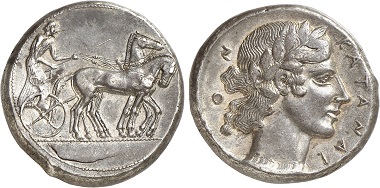translated by Sylvia Karges
Naxos was the first Greek city founded on Sicily. Today we will take a look at its coins, as well as the coins of Leontinoi, founded by Naxos.
Naxos. Tetradrachm, ca. 460. From Gorny & Mosch Auction 215 (2013), 695.
The first Greek settlement on Sicily was Naxos, founded around 735 BC. The Apollon Oracle of Delphi had sent the settlers to the island, which is why the first cult of the newly arrived was dedicated to Apollon.
From the coins we rather know the image of Dionysus, who the settlers brought with them from their former home, the island of Naxos. Therefore, they must have identified themselves more with him than Apollon.
The tetradrachm displayed above belongs to the most beautiful specimens Greek coinage has produced. Even in antiquity, it was supposed to be something special. All too happily, one would like to see in it the first striking of the returned inhabitants of Naxos, who were able to return home after the death of Thrasybulus of Syracuse. The gorgeous head of Dionysus, featuring a mysterious smile, appears to be bursting out of the effigy and stepping out of the coin’s surface. This image has inspired die cutters of all centuries. We know that Jean-Jacques Barre, chief engraver of the Monnaie de Paris, had one of those specimens in his personal collection.
Naxos. Tetradrachm, ca. 415. From NAC Auction 82 (2015), 47.
This coin displays the same motif, but implemented in a classical way. We see the god Dionysus, wearing a broad fillet, decorated with ivy. On the reverse, a silenus is again depicted. He is holding a thyrsus, a long staff, which is crowned by a pine cone.
In 403, Syracuse destroyed Naxos, which is when the coin production of the city ended.
Leontinoi. Tetradrachm, ca. 440-425. From Gorny & Mosch Auction 219 (2014), 38.
Leontinoi, located near Syracuse, was founded by Naxos around 729. Its main God was Apollon, just as in neighboring Catane, which was also founded by Naxos. It almost seems like these two cities were competing in their coin production in regards to who would have the most beautiful head of Apollon on their coins.
Leontinoi was heavily influenced by Syracuse. It was only with the fall of Thrasybulus in 466 that the city was able to free itself from Syrauses’ domination. Numismatically, this presented itself by the disappearance of the quadriga on the obverse, which was felt as being Syracusan, and its replacement with the hitherto existing reverse image of Apollon. The lion, depicted on the reverse, was already found on the reverse in archaic times. On the one hand the lion alludes to the name of the city, on the other, being the sacred animal of Apollon, it points to the patron saint of the city. The grains symbolize the fertile lands around Leontinoi.
In 422 Syracuse occupied Leontinoi and destroyed large parts of the city. This is when the production of these grand tetradrachms stopped.
Catane. Tetradrachm, ca. 450-445. From Gorny & Mosch Auction 236 (2016), 35.
Already in ancient times, Catane, located on the bottom of Mount Etna, was one of the big centers of Sicily. Today, there are barely any remnants of the once important structures to be seen. Mount Etna buried most of the city under its solidified lava masses.
Coinage only started to be struck again after 466, when Thrasybulus of Syracuse was expulsed. It was his predecessor Hieron, who had resettled the former inhabitants of Catane to Leontinoi, and then founded a new city, Aitna, in its now deserted place. This decision was revoked in 466 when the period of the tyrants of Syracuse ended. The inhabitants moved back to their old place of residence.
When Dionysius I conquered the city in 403, the coinage of Catane ceased to exist. The people of the city were enslaved and the city was newly resettled with mercenaries from Campania.
In the following part we will talk about the history of Sicily during the Hellenistic period.
This article was originally published in MünzenRevue 4/1997.
Please find all parts of this series in our archives.
If you are interested in Sicily, you should certainly check out the numismatic diary “Sicily in full bloom”. Find this series also in our archives.









